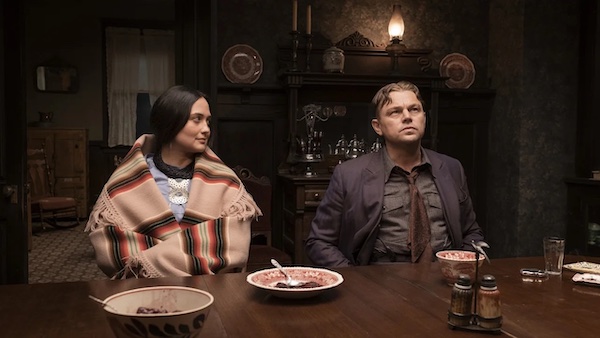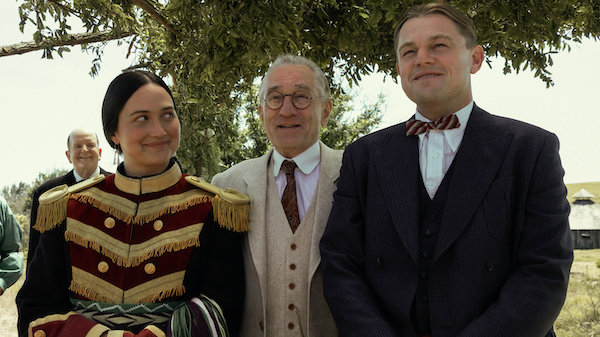Film Review: “Killers of the Flower Moon” — Lethal Snake Oil Salesmen
By Peter Keough
Killers of the Flower Moon is an exercise in kaleidoscopic, cubist storytelling that is, among other things, an epic on the art of the grift.

Lily Gladstone and Leonardo DiCaprio in Killers of the Flower Moon. Photo: AppleTV+
Martin Scorsese can sometimes play it fast and loose when it comes to chronology, as is the case in his 206-minute-long, sprawling, gnarly, visionary, and epic Killers of the Flower Moon, based on David Grann’s 2017 book about a series of murders on an oil-rich Osage reservation in Oklahoma in the 1920s. The timeline is intertwined and knotty and includes at least one flashback within a flashback. It’s a kaleidoscopic, cubist kind of storytelling, like a cinematic tapestry, or a flowing Osage blanket woven with the images of figures from myth and history, and it evokes a sense of timelessness, and timeliness — for these events from a century ago are urgently relevant today.
It opens with the first of many rites of mourning as Osage elders prepare to bury not the hatchet, but a peace pipe representing the nation’s culture and traditions. These have been lost, they lament, to the encroachment of white men, who have evicted them from their territory in Kansas and resettled them in a godforsaken wasteland. But, as seen from above in one of the film’s frequent God’s-eye point-of-view shots, the barren earth suddenly erupts, Beverly Hillbillies style, with black gold. A series of silent newsreel clips with intertitles follows — another one of Scorsese’s stylistic tropes — in which the Osage have become fabulously wealthy, with more fancy cars per capita than any other demographic in America, with women dressed flapper style and layered with jewelry, with champagne and cash flowing as freely as the fossil fuel.
But there is a catch, one that the film gradually clarifies: the Osage people have “headrights” to their property, meaning it can only be inherited, not sold. Most of those who can claim these rights are declared incompetent by racist government directives: their money is put in trusts managed by often corrupt bankers. But if their heirs are of the right color, they get the money free and clear. Hence the influx of white scalawags, grifters, crooks, and killers seeking Osage brides in hopes that they will become rich men upon the deaths, natural or not, of their spouses — and any other kin that stand in the way of their entitlement.
Among the scruffy opportunists flooding the chaotic streets of the Osage town of Hamilton (curiously resembling Asteroid City) is Ernest Burkhart (Leonardo DiCaprio). Fresh from post-World War I France, where he served as a cook, and still wearing his scruffy uniform, he’s looking for employment from his uncle, William Hale (Robert De Niro), a wealthy cattle ranch owner.

Lily Gladstone, Leonardo DiCaprio, and Robert De Niro in Killers of the Flower Moon. Photo: Apple TV+
During a demeaning interview Hale leeringly inquires into Ernest’s sex life and suggests that he call him “King,” just like he did when he was a kid. Hale advises him not to be “simple” and not cause trouble and he’ll make it big. Before setting him up with a job as a driver he gives him a book about the Osage, telling him that they are smart. They might not talk much, but that doesn’t mean they don’t know everything, and that they are the finest people on earth.
Cut to an Osage young man vomiting in his death throes. A woman relates a litany of the names of those of her people who have met with untimely deaths since the discovery of oil and the subsequent influx of white suitors (the estimated final toll ranges from 60 to the hundreds). Some of these deaths have been violent, others the result of a mysterious “wasting illness.” It is the voice of Mollie Burkhart (Lily Gladstone) and perhaps this might be [spoiler?] testimony that she delivers to officials in Washington later in the film. Hers is the only voiceover — a true distinction for a director prone to its practice. It seldom recurs, and she doesn’t say much, but its presence lingers like a kind of omniscience.
Mollie meets Ernest when he offers her a ride, and though she tells him to his face and admits to her friends and sisters that he’s a “coyote” out for her money, she’s still attracted to him and sees that he is attracted to her as well. In short order they are married, start having kids, and even after her sisters start dying and her mother and she both come down with the “wasting illness,” she doesn’t turn on him.
Is she a knowing victim? Gladstone’s performance is reserved but nuanced and suggestive of unspoken awareness of the true nature of her plight and her options. Her face in every scene looks like an image from a painting by some Italian master. When she initially flirts with Ernest she permits him a Mona Lisa smile, and when at last she confronts him with her unforgiving grief she looks like a Raphael Madonna. Her presence in the film is pervasive and subliminal. She is the film’s conscience and perhaps its consciousness.
In a detail that no doubt appealed to Scorsese, she finally confesses her suspicions to her priest (the local religion combines both Catholic and Osage elements). That, as well as some well-placed bribes, draws the Federal government’s interest and results in a visit from agent Tom White (Jesse Plemons ) and a team of investigators. A long anticipated, though not totally gratifying, series of disclosures, confrontations, and comeuppances ensue. At this point, Killers of the Flower Moon takes on the guise of a police procedural.
Still, at its core, according to Scorsese, this is a love story centered on Mollie’s disastrous relationship with Ernest, making it one more of his perverse romantic couplings or folies a deux, as seen in films ranging from Taxi Driver (1976) to New York, New York (1977), from Raging Bull (1980) to Casino (1995). But its dynamics are elusive: here Mollie’s moral stature and depth of character so outclasses her spouse that he shrivels in comparison.
More to the point is Ernest’s relationship to Hale, the former increasingly mirroring his uncle’s mannerisms, mugging, and attire, like a child taking on the traits of the parent who abuses him. I was reminded of the performance of then teenage DiCaprio in This Boy’s Life (1993) in which he mimics the shtick of his sociopathic stepfather, played by De Niro. In that case, the imitation was ironic and he is punished for it. Here it’s the desperate attempt by a sycophant for approval; he is also punished for it here in a bizarre, ritualistic, and humiliating paddling that takes place in a Masonic temple.
However Ernest isn’t the only one who is taken in by Hale. So is everyone in Osage County, white and Native residents alike. They regard him as a mentor, sage, and benefactor. Not only does he underwrite hospitals and ballet schools, but he has also learned the Osage language and their ways. He genuinely admires, perhaps even loves, the Native people, which is why they believe in his benevolence and are blind to his evil.
This begs comparisons to the present day. Robert De Niro has been ridiculed for equating Hale to a certain notorious conman and grifter who is also revered by some and has convinced them that he speaks their language. But there are crucial differences. Hale preyed on his victims by taking advantage of their good nature; today’s version exploits his suckers by appealing to their worst inclinations and turning them into virtues, even while holding them in contempt. So far that’s proven to be the better strategy.
Peter Keough writes about film and other topics and has contributed to numerous publications. He had been the film editor of the Boston Phoenix from 1989 to its demise in 2013 and has edited three books on film, most recently For Kids of All Ages: The National Society of Film Critics on Children’s Movies (Rowman & Littlefield, 2019).
Tagged: David Grann, Killers of the Flower Moon, Leonardo DiCaprio, Lily Gladstone, Martin Scorsese
